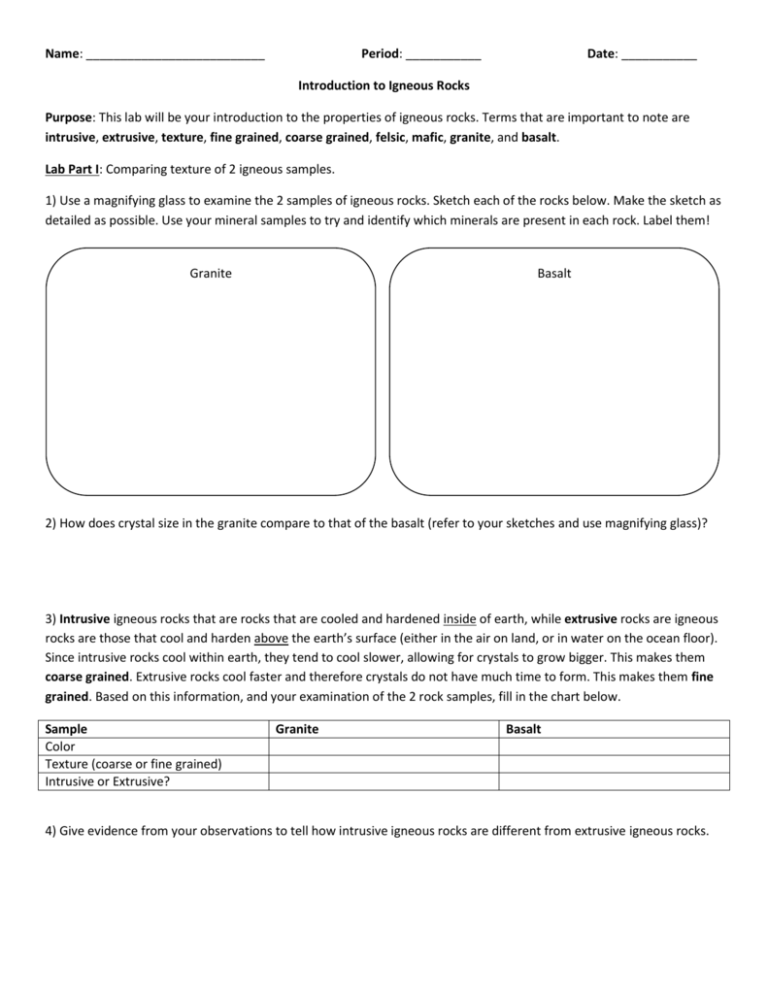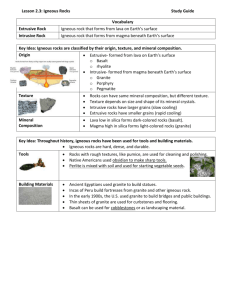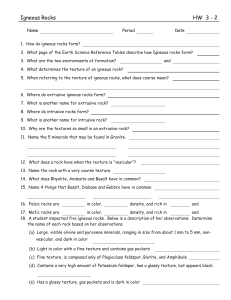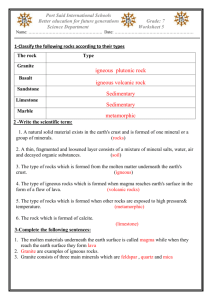Name
advertisement

Name: __________________________ Period: ___________ Date: ___________ Introduction to Igneous Rocks Purpose: This lab will be your introduction to the properties of igneous rocks. Terms that are important to note are intrusive, extrusive, texture, fine grained, coarse grained, felsic, mafic, granite, and basalt. Lab Part I: Comparing texture of 2 igneous samples. 1) Use a magnifying glass to examine the 2 samples of igneous rocks. Sketch each of the rocks below. Make the sketch as detailed as possible. Use your mineral samples to try and identify which minerals are present in each rock. Label them! Granite Basalt 2) How does crystal size in the granite compare to that of the basalt (refer to your sketches and use magnifying glass)? 3) Intrusive igneous rocks that are rocks that are cooled and hardened inside of earth, while extrusive rocks are igneous rocks are those that cool and harden above the earth’s surface (either in the air on land, or in water on the ocean floor). Since intrusive rocks cool within earth, they tend to cool slower, allowing for crystals to grow bigger. This makes them coarse grained. Extrusive rocks cool faster and therefore crystals do not have much time to form. This makes them fine grained. Based on this information, and your examination of the 2 rock samples, fill in the chart below. Sample Color Texture (coarse or fine grained) Intrusive or Extrusive? Granite Basalt 4) Give evidence from your observations to tell how intrusive igneous rocks are different from extrusive igneous rocks. Lab Part II: Examining Density of 2 igneous rocks. 1) Next we want to examine the density of the two samples provided (granite and basalt) and this will lead us to determining where they are found. To find the density of an object you must use the following equation: Density mass( g ) volume(cm 3 ) You will have a scale and a volumetric flask available for use. You must use these two devices to figure out a way to find the density of each of your rocks. (Hint: 1mL = 1cm3) Sample Mass (g) Volume (cm3) Density (g/cm3) Granite Basalt Now that you have determined the density of each of your rock samples, let’s examine the figure below. The diagram shows a continental plate and an oceanic plate at a convergent boundary (we will learn more about this in a few weeks!) The oceanic plate subducts beneath (slides under) the continental plate when they meet. 2) What about the density of the oceanic plate do you think causes it to slide beneath the continental plate? 3) Based on your answer to #2 and your density calculations in #1, what rock (basalt or granite) composes most of the oceanic plate? What rock composes most of the continental plate? Explain your reasoning for your answers. Support with your data!








